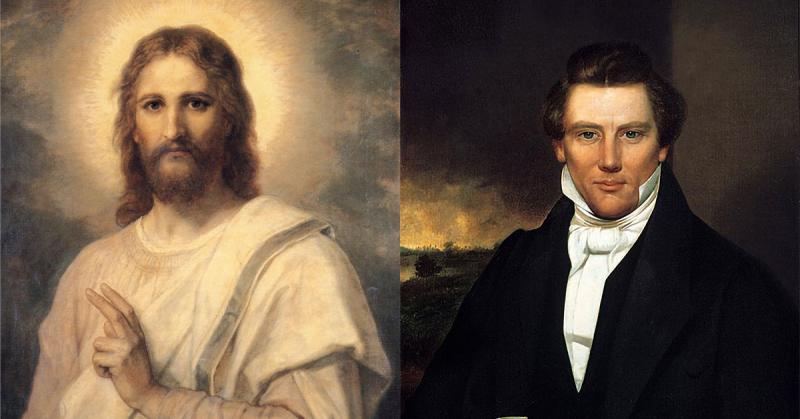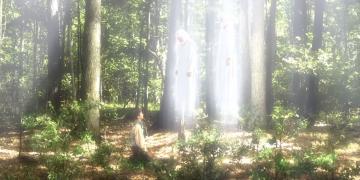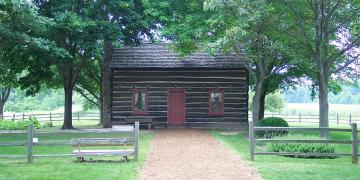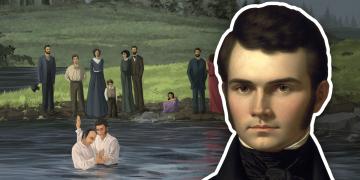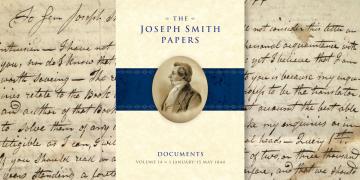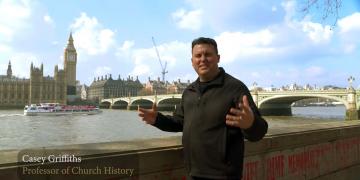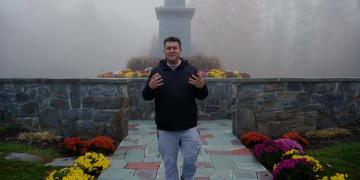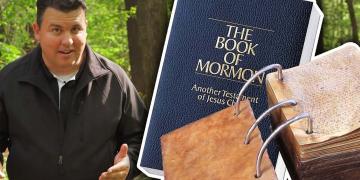You are here
Celebrating the Restoration Day 1: Seeing the Hand of God in History
Twenty-five years ago, I was deeply struck, seeing up close many striking details present in the rise of Christianity two thousand years ago with parallels in the rise of the Restoration of the Gospel of Jesus Christ two hundred years ago. At that time, I was teaching a course at BYU on Masada and the world of the New Testament. At the same, I was editing BYU Studies and Church history publications for the Joseph Fielding Smith Institute at BYU.
Fascinatingly, the social and historical developments that set the stage for Jesus Christ have strong counterparts in the cultural and religious developments that prepared the way for the Restoration of the Gospel by Joseph Smith. As I began tabulating these parallels, the case became stronger and more interesting than I had ever surmised. I ended up publishing the following article about these similarities that exist between early Mormonism and early Christianity.
I have spent much of my life studying these two focal points in world history. It makes sense that certain things needed to be in place in order for Jesus to have had even a chance of accomplishing his mission, attracting a committed following, and leaving a lasting legacy. Many of those same conditions also needed to be present in order for Joseph Smith to fulfill his calling, to find converts in large numbers, and leave his indelible impact on the world. Both Jesus and Joseph spoke words that were treasured, written down, and published widely. Both Jesus and Joseph ordained leaders, established an organization that could carry forward after their martyrdoms, only 33 and 38 years after their births.
Down to minute details, these comparisons show that if either Jesus or Joseph had been born 30 years earlier, they would have been born in tumultuous times at the beginning of new political regimes, either under King Herod or in the Revolutionary War. Getting even a foothold would have been scarcely possible. Had either of them been born 30 years later, they would have been overwhelmed with devastating civil wars, the Jewish War in the 60s or the War between the States in the 1860s. Either way, they could not have accomplished most of what they needed to do. The window was tiny.
As my article indicates, these unique conditions offer a cumulative case of impressive evidence that the hand of God was at work in these two parallel moments in the history of the salvation of all the world. Four charts (Tables 1, 2, 3, 4) make it easy for readers to scan through the lists of these crucial developments. They began over three hundred years beforehand, preparing the way for the impacts of the long-awaited and foreordained lives of the promised Savior Jesus Christ and of his prophetic Restorer Joseph Smith.
Table 1: Parallels in Preparations and Historical Settings
|
Early Christianity |
Early Mormonism |
|---|---|
|
c. 330 B.C. Alexander the Great spreads widely the new influence of Hellenism and rationalism, Plato, Aristotle, Zeno, Epicurus |
c. 300 years before Joseph Smith, rationalism, Renaissance and Reformation widely influential, Copernicus, Columbus, Luther, Descartes |
|
Septuagint Greek version of the Old Testament is translated by c. 200 B.C., becomes accepted as standard by many Jews, translated by 70 scholars into the common daily language, used heavily in early Christian writings |
The King James Version is completed in 1611, 200 years before Joseph Smith, becomes accepted as the standard English Bible, translated by 55 scholars into the common daily language, used heavily in Restoration writings |
|
167 B.C. Maccabean revolt against Seleucids in Jerusalem, reign of strict Jews, their descendants become the Pharisees, purists, separatists |
165 years before Joseph Smith, Cromwell rebels in 1640, strict Puritans reign, their descendants flee from secularism |
|
Battle of Actium, 31 B.C., Augustus Caesar defeats Anthony and Cleopatra, ushering in a new era of Roman government and society |
30 years before Joseph’s birth in 1805, the American Revolution dramatically begins a new era, George Washington defeats the British |
|
The Pax Augusta affords worldwide peace, general civil and individual freedom with unprecedented optimism and unity |
United States Constitution and Bill of Rights protects individual freedoms, promotes peace and engenders great optimism and unity |
|
Old aristocratic arrangements overthrown while underlying Roman mores remain in place, period of legal transition, new horizons beckon |
Tory ties to England broken while underlying common law and economy remains in tact, period of legal transition, new frontiers beckon |
|
Romans very attentive to their own gods while mostly tolerating the worship of other gods such as Isis, Mithras, a pluralistic religious world |
Most states and religious groups very attentive to their own observances while mostly tolerating religious freedom, a pluralistic religious world |
|
Religious freedoms for the Jews are protected by legal decrees by Julius Caesar and others |
Religious freedom is specifically protected by bills of rights and constitutional provisions |
|
Opportunity to form private organizations, including funerary collegia, client cults, house churches, business partnerships |
Freedom of association is protected, the rise of corporations and trusts allow formation of private religious and business organizations |
|
Expansion of Roman road system, travel becomes common over considerable distances. Paul travels extensively, including trips to Asia Minor, Greece, Jerusalem, and Rome |
Opening Cumberland Gap, canals and federal roads allows for explosive mobility. Joseph Smith travels extensively, including 4 trips to Missouri, others to Boston, Canada, and Washington |
|
Mediterranean made safe for sea travel as pirates are eliminated, harbors built |
Safety and efficiency of Atlantic crossings allow missionary travel, immigration, piracy controlled |
|
Economic expansion in Judea under Herod the Great produces unprecedented prosperity, independent opportunities, fabulous construction projects, worker dislocations, family and social changes |
Economic opportunism blossoms with new markets, financial independence and ability, the Erie Canal, western boom towns along the Mississippi, bringing personal mobility, family and social changes |
|
Roman innovation brought an age of new construction, engineering, and science, building aqueducts, roads, harbors |
Industrial revolution brings new age of innovations and inventions, making of steam engines, railroads, machines |
|
Education and literacy is high, even higher than once thought, noticeably among Jews |
Education and literacy is widespread and highly valued, converts are educated readers |
|
Greek is spoken as the common language in the eastern empire, a second language in the west |
English as a widespread language carried abroad by the expansion of the British empire |
|
Books, parchment production, scrolls, and libraries are more common and available, a blossoming of literature, Horace, Virgil |
Printing presses, books, newspapers, and libraries are available in most towns, blossoming of romantic literature, transcendentalism |
|
A time of individual religious choice, particularly between many Jewish sects and movements, Pharisees, Sadducees, Essenes, as well as devotees of numerous Greek and Roman gods, Stoics, Cynics, Epicureans, and others |
A time of personal religious choice in America, between many churches, Congregationalists, Episcopalians, Methodists, Baptists, Catholics, Quakers, Mennonites, Unitarians, Seekers, Transcendentalists, and others |
|
Religious controversy is bewilderingly common, spontaneous religious questions and arguments especially in Jewish culture |
Religious controversy is an ordinary part of public discourse, strong opinions on religious issues mattered to individuals in America |
|
Old religions threatened, for example Artemis cult in Ephesus (Acts 19), old ways becoming expensive to maintain |
Old religions are vulnerable to revivals, reforms, new religions offer less expensive and challenging alternatives |
|
Messianic expectation is high, ideal utopian age expected by many groups, religious agitation is high, large crowds come out to see John the Baptist or Jesus |
Apocalyptic fervor is high, millenarianism is popular, visionary utopian societies flourish, religious frenzy is high, large crowds gather for revivals throughout the country |
|
Divination, incantations, exorcism, mysticism present in respectable popular culture |
Visions, dreams, seers, amulets, supernaturalism present in respectable popular culture |
|
Galilee, an expansion area for Jewish settlement in the first century before Christ |
New England, an expansion area for settlement in the eighteenth century |
|
Galilee, stony soil, demanding hard work, harboring revolutionary tendencies, freedom Zealots distrusted |
New England, stony soil, hard work, revolutionary independence, freedom advocates disdained |
|
Rise of powerful parties battling for control in the Jewish world, Sadducees, Pharisees, Zealots |
Rise of political parties struggling for control over state, regional, and federal politics |
|
Christians flee Jerusalem, James (brother of Jesus) killed, Christians dispersed, Peter, Paul and others martyred, nowhere to gather |
Exodus of Mormons out of Illinois, Joseph and his brother Hyrum martyred, the Saints trek across the Plains and gather to Zion |
|
Jewish Civil War (4 years long) and destruction of the Temple, A.D. 66–70, about 35 years after the ministry of Jesus |
American Civil War (4 years long), devastation of Missouri and elsewhere, 1861–1865, 31–35 years after the organization of the Church |
Table 2: Comparable Foundings: Jesus and Joseph Smith
|
Early Christianity |
Early Mormonism |
|---|---|
|
Jesus’ ministry appears suddenly, is dramatic, innovative, controversial, and polarizing |
Joseph Smith’s ministry is sudden, dramatic, innovative, controversial, and polarizing |
|
The new religious movement is initiated by angels appearing to Zacharias, Mary, Joseph, the shepherds at Bethlehem; Gabriel appears at least five times |
The new religious movement is initiated by angels including Moroni, John the Baptist, Peter, James, John; Moroni appears at least twenty times |
|
The voice of God the Father at baptism acknowledges the Son |
God the Father at the First Vision introduces the Son in similar words |
|
Opposition by Satan, temptations of Jesus, expelling devils |
Confrontations with Satan and his forces, exposing angels of darkness |
|
The movement grows around a central kinship family, that of Jesus, Mary, John the Baptist, James the brother of Jesus, John |
The movement centers on the Smith family, Joseph Sr., Lucy, Joseph, Emma, Hyrum, Samuel, uncles, cousins |
|
Family ties are crucial among the earliest converts: Peter and Andrew; the sons of Zebedee; family of Lazarus, Mary, Martha |
Family ties are close among the Smiths, the Whitmers, Knights, Johnsons, Pratts, Snows, and many other member families |
|
Jesus is a remarkable youth, answering the rabbis questions at the temple and teaching in the synagogue |
Joseph Smith at young age translates, gives bold new answers to prevailing questions |
|
Memories and sayings are preserved, letters and books are written and kept very early |
Extensive record keeping from the beginning, revelations recorded, diaries and minutes kept |
|
Various accounts survive of baptism of Jesus |
Various accounts survive of the First Vision |
|
Jesus and Paul preach in the synagogues |
Missionaries preach in others’ churches |
|
Jesus opposes the temple establishment, runs counter to the prevailing culture |
Joseph Smith opposes many democratic themes, runs counter to dominant politics |
|
Moses and Elijah with Peter, James and John on Mount of Transfiguration; Jesus draws strength by association with powerful figures |
Appearances of Moses, Elijah, Peter, James and John; Joseph draws strength by connection with powerful past figures |
|
House churches at first, in Capernaum, Thessalonica, Philippi, Corinth |
House churches at first, Peter Whitmer farm, John Johnson home |
|
Some teachings not openly shared with all, cast not your pearls or holy things before the dogs (Matthew 7:6) |
Ritual teachings kept esoteric, sacred, certain teachings or experiences not openly taught at first |
|
Jesus and the Temple, he always went there when in Jerusalem, taught there daily, healed there, would rebuild the temple |
Joseph Smith and the Temple, always concerned about establishing temples in Kirtland, Independence, Far West, Nauvoo |
|
Jesus and missionary fervor, very early, sent out the Twelve and then the Seventy, eventually to remote locations |
Joseph and missionary fervor, at time of great risk, sent out the Twelve and then Seventies, eventually to remote locations |
|
New scripture created, Christian texts added to Jewish |
New scripture created, Mormon revelations added to Jewish and Christian writings |
|
Bold new practices, some do not last, such as holding property in common |
Bold new practices, some do not last, such as united order, wealth redefinition |
|
Great promises of exaltation, entering God’s presence and obtaining all, testimonials of benefits in spite of costs |
Great promises of exaltation, becoming as God and progressing eternally, testimonials of benefits in spite of costs |
|
Built on ideas found in the basic surrounding culture, parallels can be seen in some of the Dead Sea Scrolls and contemporary writings |
Built on words and attitudes in surrounding environment, parallels can be found in the nineteenth-century religious milieu |
|
Cultural continuity with conventional Jewish religion was high |
Cultural continuity with conventional Christianity was high |
|
Heavy dependence on the Old Testament, making strong truth claims about the original meaning of old scripture |
Heavy dependence on the Old and New Testaments, making strong truth claims about understanding their original meanings |
|
Readapting broad Old Testament themes for Christian purposes |
Reworking of biblical themes for Mormon purposes |
|
Claims of power to speak and act with divine authority |
Claims of authority to speak and act with divine authority |
|
Pre-creedal statements of belief are fluid, simple |
Early articles of faith are fluid, uncomplicated |
|
Cosmic signs, star at the birth of Christ, omen at death of Herod Agrippa |
Stars fell in Missouri, 1833, seen as a sign of heavenly import |
|
Prophecy about impending destruction, apocalyptic eschatology (see Matthew 24) |
Prophecy about impending millenarian destruction, the last days (see D&C 45) |
|
Miracles of Jesus are impressive and abundant |
Miracles of Joseph are important and persuasive |
|
Fears of occult powers are part of the undoing of Jesus after the raising of Lazarus, as seen in the accusation that he was a trickster |
The undoing of Joseph Smith is traceable to his claims of access to the supernatural, suspicions that he was a deceiver |
|
Violent crucifixion of Jesus, age 33 |
Violent shooting of Joseph Smith, age 38 |
|
Death of Jesus is caused by the failure of Pontius Pilate to protect him |
Death of Joseph is caused by the failure of Thomas Ford to protect him |
Table 3: Analogous Apostleships
|
Early Christianity |
Early Mormonism |
|---|---|
|
Uncertainty about immediate apostolic succession in leadership in Jerusalem, Corinth, after the unexpected death of Jesus |
Similar uncertainty about immediate apostolic succession in leadership in Nauvoo after the unexpected death of Joseph |
|
Group validation at Pentecost in Acts 2, rapid initial growth, enthusiasm; validation of Peter as successor |
Group spiritual outpourings, rapid burst of growth, enthusiasm; validation of Brigham Young as successor |
|
Separation of spiritual and temporal administration by the early apostles in Acts 6 |
Division of responsibilities between Aaronic and Melchizedek priesthoods |
|
Joining requires little teaching; membership marked by baptism, Acts 3, 8 |
Converts join after little time or training; membership marked by baptism |
|
People join from all social and economic groups, but mainly middle class, unaffiliated |
People join from all strata of society, but mainly middle class, mobile |
|
Great success comes in territories that have been recently populated, Philippi, Corinth |
Great success comes in settling in expansion areas, Western Reserve, Missouri, Nauvoo |
|
Women play important roles in the community, exceeding the opportunities normally afforded in the surrounding culture |
Women given important roles, organization, vote, service, exceeding those normally afforded in nineteenth century culture |
|
Great interest in prophecy, foretelling the future |
Prevalence of futuristic speech, prophetic predictions |
|
Speaking in tongues in Acts, other gifts of the spirit in Corinth |
Speaking in tongues in Kirtland, other gifts of the spirit in Nauvoo |
|
Divisions arise quickly in Corinth and Galatia |
Divisions arise soon in Kirtland and Missouri |
|
False apostles reject Paul’s authority, apostasy underway |
Apostasy of half of the twelve apostles in Kirtland in 1837 |
|
Free riders and false prophets are dealt with severely; social costs of membership are high |
Nonconformists expelled quickly; distinctive stigmas of membership present entry barriers |
|
Leaders are often imprisoned; Peter, John, Paul in Jerusalem; Paul in Philippi, Caesarea |
Leaders are often imprisoned; jails in Richmond, Liberty, Carthage |
|
Paul rises above the rough treatment of the prison guard in Philippi |
Joseph rises above the vulgar treatment of prison guard in Richmond |
|
Paul articulates phrases that become elements in enduring statements of faith |
Joseph Smith articulates similar statements that become Articles of Faith |
|
Paul travels to Rome to plead his cause and to testify to Caesar |
Joseph travels to Washington to set his cause before the President |
|
Letters of Peter, John, James, Jude and Paul become scripture in the New Testament |
Joseph Smith’s letters are canonized in Doctrine and Covenants 121–23, 127–28 |
|
Concerns arise in Thessalonika and Corinth over those who had died before knowing the truth |
Concerns arise in Nauvoo over those who had died, such as Alvin, before the restoration of the truth |
|
Great promises, to become sons of God |
Great promises, to rise to celestial glory |
|
Earliest priesthood instructions in 1 Corinthians deal with administration of the sacrament |
Earliest instructions in the 1830 Articles and Covenants deal with administration of the sacrament |
|
Borrowing of Jewish psalms while writing new Christian hymns |
Borrowing of Christian hymns while writing new LDS hymns |
Table 4: Similar Aftermaths
|
Early Christianity |
Early Mormonism |
|
Ideological opposition through emperor-worship, this-worldliness |
Ideological opposition from secularism, atheistic scientism |
|
The end did not come as quickly as assumed (see 2 Peter 3:1–9), people adjusted |
The end did not come as expected, people need to adjust to unfulfilled expectations |
|
Jewish Civil War (5 years long) and destruction of the Temple, A.D. 66–70, 35 years after the ministry of Jesus |
American Civil War (5 years long) and devastation of Missouri, 1861–1865, 31 years after the organization of the Church |
|
Christians get out of Jerusalem, James (brother of Jesus) killed, Peter goes to Mesopotamia, Christians move to Pela1 |
Mormons get out of Illinois, Joseph and his brother Hyrum killed, the Saints trek across the Plains |
|
Impact of Jewish War on Jewish history, loss of Jewish influence in Roman empire2 |
Great impact of 1857 on Mormon history, Mormon isolation in the West |
|
No real gathering place, concentration in certain cities around bishops, Rome eventually becomes central in the West |
Gathering to Zion as focus of concentration except for dissenting groups, Salt Lake City becomes central in the West |
|
Struggle against multiple traditions and interpretations of Christ |
Struggle against many dissenters and early schismatic groups |
|
Some early Christians stop with the baptism of John (Acts 19:2), do not receive the Holy Ghost through the higher priesthood |
David Whitmer and some stop with events of 1829-31, baptism and initial teachings, do not accept the higher priesthood |
|
Sons of Sceva and early Jewish opponents to Christianity (Acts 19:14) |
Joseph Smith describes opposing Campbellite pamphleteers as sons of Sceva3 |
|
Cultural baggage brought by converts into local congregations, hellenistic ideas, notions of Roman patronage, honor and shame |
Cultural baggage brought by converts into church thinking and writing, influence of Protestantism on Mormon writers |
|
Effect of loss of the Temple in Jerusalem, Christian envy of the temple |
Temporary loss of the temple in Nauvoo, continued focus on temples |
|
Memory of Jesus is transmitted by Paul and John to Polycarp and second generation |
Memory of Joseph is transmitted by Brigham Young and John Taylor to next generation |
|
Early Christians Polycarp and Ignatius focus on historical facts, later writers on theology |
Early Mormons stand more on historicity of founding events, less on theology |
|
Religion is based on narrative theology, not systematic theology |
Religious expression is based on episodes and personal experiences, not theory |
|
Docetists are scandalized by supernatural elements in Christ |
RLDS and secular Mormons minimize miraculous beginnings of Mormonism |
|
Doctrinal disputes arise very early, alternative teachings abound |
Doctrinal disputes and dissenting group form very early |
|
Concern over asserting and establishing orthodoxy in the face of diverse heresies, Gnostics, Jewish syncretists, or secularists |
Concern over asserting and establishing orthodoxy as divergent groups arise, Rigdonites, Godbeites, Reorganites |
|
Public concerns and doubts about loyalty of Jews and Christians to the Roman Empire |
Public concerns and doubts about Mormons, kingdom building and loyalty to United States |
|
Paul frequently in courts of law, early suspicions and legal trials of Christians in Pontus |
Joseph Smith frequently in courts of law, suspicious legal trials of Joseph Smith in New York |
|
Jews paint Christians in poor light, bad public image4 |
Mormons receive terrible image in the establishment press |
|
Christians are considered to be fanatics |
Mormons are considered to be fanatics |
|
Christians are used as scapegoats for great fire of Rome by Nero5 |
Mormons are used as scapegoats in 1857 U.S. politics |
|
Self-identity of Christians is established by martyrdoms of Ignatius, Polycarp, whose deaths come at crucial moment of failed expectation6 |
Self-identity of Mormons is established in suffering and martyrdoms, which reinforce the faith at crucial moments of failed expectations |
|
Rise of apologetic and polemical writings as interaction with host culture increases |
Rise of apologetic debates as Mormons emerge in early twentieth century |
|
External discourse shifts to internal discourse in the late second century |
Some Latter-day Saints talking more in terms of the world in its second century |
|
Epidemics plague Roman empire allowing Christianity to grow more rapidly than the general population7 |
U.S. Civil War and World Wars I and II allow for population advances of Mormons vis-a-vis the rest of the population |
|
Early Christians find theological meanings for suffering in God’s schooling8 |
The Saints find theological meanings for suffering as valuable human experience |
|
Success of early Christianity is based largely on love and welfare to the sick and needy9 |
LDS emphasis on charity and welfare, caring for the sick and the poor |
|
Callistus, bishop of Rome, approves just concubinage for Christian women10 |
Mormon practice of plural marriage |
|
Importance of urban centers, urban Christianity in the second and third centuries |
Importance of stakes, missionary success in urban settings in modern era |
|
Diocletian’s first edict of 303 required confiscation of church property, meetings forbidden, second edict arrested clergy11 |
Edmunds Act (1882) leads to the arrest of leaders, Edmunds-Tucker Act (1887) to the confiscation of church property |
|
Edicts requiring all inhabitants of the empire to sacrifice to Roman gods, on pain of death, selectively enforced12 |
Extermination Order in Missouri, selectively enforced |
Further Reading
John W. Welch, “Early Mormonism and Early Christianity: Some Providential Similarities,” in Window of Faith: Latter-day Saint Perspectives on World History, ed. Roy A. Prete (Provo, UT: Religious Studies Center, Brigham Young University, 2005), 17–38. And reprinted in The Religious Educator.
Read the Other Restoration Posts
- 1. W. H. C. Frend, Martyrdom and Persecution in the Early Church (Oxford: Basil Blackwell, 1965), 171.
- 2. Frend, Martyrdom and Persecution, 226–27.
- 3. Joseph Fielding Smith, comp., Teachings of the Prophet Joseph Smith, 99.
- 4. Frend, Martyrdom and Persecution, 178–88.
- 5. Frend, Martyrdom and Persecution, 167.
- 6. Stark, The Rise of Christianity, 187.
- 7. Stark, The Rise of Christianity, 77.
- 8. Stark, The Rise of Christianity, 80.
- 9. Stark, The Rise of Christianity, 87.
- 10. Stark, The Rise of Christianity, 111.
- 11. Frend, Martyrdom and Persecution, 477–520.
- 12. Frend, Martyrdom and Persecution, 505.
Subscribe
Get the latest updates on Book of Mormon topics and research for free


